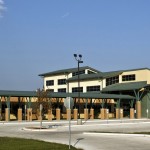Green school investments pay dividends for students
 Published in the San Antonio Express-News
Published in the San Antonio Express-News
Parents don’t always have the option of choosing where their children attend school. However, they do have the ability to advocate for good school buildings.
Often, during the consideration of school improvement projects, questions come up about the importance of a green school. Other than being a good environmental steward, there are several reasons to support green investments in schools.
A green school can provide a healthier environment for children. Green building is not just about recycled materials or solar panels. Green building addresses all kinds of issues including indoor air quality, natural lighting and acoustics.
When it comes to the place where children spend the majority of their days, good indoor air quality is essential. Simple measures can reduce particulates, increase fresh air and help prevent mold growth. Studies have shown that when these steps are taken, asthma rates go down and class attendance goes up.
Introducing more natural light into classrooms also has been shown to improve students’ ability to learn.
Creating a more pleasant environment offers children a place where they enjoy spending time.
Acoustics in the classroom are also important. Because children’s ears are less developed than adults’, it is more difficult for them to filter out background noises. Noises from mechanical units, hall traffic and other outside sources can interfere with learning. By designing spaces that reduce sound transmission, we can facilitate classroom instruction.
A variety of other features in green schools can impact students in different ways. Daylight sensors might automatically lower the overhead light when sunlight is readily available. A water storage system could be installed to collect air conditioning condensate and rainwater.
Recycling facilities that accommodate all kinds of materials might be placed around the campus. These are good ways to reduce demand on natural resources, and they also are effective in teaching children the value of resources. In turn, students recognize the impact they can have on their world, which is not only enlightening, but empowering.
School boards are faced with many difficult decisions every year, but ultimately their responsibility is to both the taxpayers and the students. It may seem difficult to justify added costs of green features in schools, especially during times of budget cuts. But building green makes good financial sense. Research has shown that the payback for green buildings usually ranges from three to 10 years. After that, a green school can begin to save districts money through reduced energy and water consumption costs.
Parents may not have the luxury of choosing their child’s school, but they can emphasize the importance of good facilities to their school boards. It makes sense as parents and as taxpayers. And the biggest beneficiaries are the students.
Nicole Marrone serves as the AIA San Antonio board commissioner for professional affairs.




